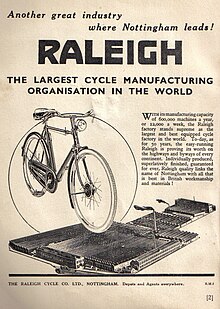Wikipedia:Featured picture candidates/Gawthorpe Hall and Sir Frank Bowden, 1st Baronet: Difference between pages
new nom |
Les woodland (talk | contribs) Add book |
||
| Line 1: | Line 1: | ||
[[Image:Raleigh head badge.JPG|thumb|right|Raleigh US [[head badge]]]]'''Sir Frank Bowden, 1st Baronet''' (30 January 1848–25 April 1921), was the founder of the [[Raleigh (bicycle)|Raleigh]] [[Bicycle]] Company. |
|||
===[[Wikipedia:Featured picture candidates/Gawthorpe Hall|Gawthorpe Hall]]=== |
|||
When Bowden was 24 when he made a fortune in the [[stock market]]. When he returned from [[Hong Kong]] he was seriously ill. His doctor gave him six months to live. Bowden took up [[cycling]] on his doctor's advice. After recovering he bought Messrs Woodhead, Angois and Ellis, the company in Raleigh Street, Nottingham, from which he purchased his [[bicycle]]. It was making three bicycles a week. Production rose and three years later Bowden needed a bigger workshop, which he found in a four-storey building in Russell Street. He changed the company's name to Raleigh Cycles to commemorate the original address. By 1896 it was the largest [[bicycle]] manufacturer in the world and occupied seven and a half acres in Faraday Road, Nottingham. |
|||
[[Image:Gawthorpe Hall front.jpg|thumb|250px|'''Original''' - [[Gawthorpe Hall]] is an [[Elizabeth I of England|Elizabethan]] house situated southeast of the small town of [[Padiham]], in the borough of [[Burnley (borough)|Burnley]], [[Lancashire]], [[England]]. It as a [[pele tower]], a strong square structure built in the 14th century as a defence against the invading Scots. Around 1600 a [[Jacobean]] mansion was dovetailed around the pele but the true glory of the hall was the 1850 re-design of the house by [[Sir Charles Barry]] who eventually on to design the [[Houses of Parliament]].]] |
|||
[[Image:Raleigh 1940s advert.jpg|thumb|right|Raleigh advert from 1940.]] |
|||
;Reason:A good composition showing a classical piece of British architecture, it adds substantially to the article. |
|||
;Articles this image appears in:[[Burnley]] [[Gawthorpe Hall]] |
|||
;Creator:[[User:Childzy|Childzy]] |
|||
Bowden invented the Bowden cable in 1902, replacing rigid rods used until then for brakes with a wound cable. The Bowden cable meant brakes could be worked by calipers, as is now standard, rather than by rod pulling the brake blocks up against the rim. He wrote ''Cycling for Health and Points For Cyclists'' in 1913.<ref>www.yourtotalevent.com/Sale/Sale.htm</ref>. |
|||
* '''Support as nominator''' --<font face="Comic Sans MS">'''[[User:childzy|<font color="#000000">Chil</font><font color="#E3170D">dzy</font>]]''' ¤ '''[[User_talk:childzy|<font color="#000000">Ta</font><font color="#E3170D">lk</font>]]'''</font> 17:38, 26 September 2008 (UTC) |
|||
In 1915 he was created a '''Baronet''', of the City of Nottingham on 23 June 1915. He became a Fellow of the [[Royal Geographical Society]] and a Justice of the Peace.<ref>Mosley, Charles Mosley (ed), Burke's Peerage, Baronetage & Knightage, 107th edition, (Genealogical Books) Ltd, 2003), volume 1, page 458. </ref> Bowden married Amelia Frances, daughter of Alexander Houston, in 1879. He died in April 1921, aged 73, and was succeeded in the baronetcy by his eldest son Harold. Lady Bowden died in 1937. |
|||
* |
|||
==External links== |
|||
<!-- additional votes go above this line --> |
|||
* [http://www.raleighbikes.com/ Raleigh Bikes] |
|||
{{-}} |
|||
==References== |
|||
*[http://www.angeltowns.com/town/peerage/ Leigh Rayment's Peerage Page] |
|||
*[http://www.thepeerage.com/ www.thepeerage.com] |
|||
{{start box}} |
|||
{{s-reg|uk-bt}} |
|||
{{succession box | title=[[Bowden Baronets|Baronet]]<br>'''(of the City of Nottingham) | years='''1915–1921 | before= New creation | after= Harold Bowden }} |
|||
{{end box}} |
|||
{{DEFAULTSORT:Bowden, Frank}} |
|||
<noinclude>[[Category:Featured picture nominations]] [[Category:Featured picture nominations/September 2008]]</noinclude> |
|||
[[Category:English businesspeople]] |
|||
[[Category:English cyclists]] |
|||
[[Category:English inventors]] |
|||
[[Category:1848 births]] |
|||
[[Category:1921 deaths]] |
|||
{{England-sportbio-stub}} |
|||
{{inventor-stub}} |
|||
[[cy:Frank Bowden]] |
|||
[[de:Frank Bowden]] |
|||
[[fr:Frank Bowden]] |
|||
Revision as of 07:39, 10 October 2008

Sir Frank Bowden, 1st Baronet (30 January 1848–25 April 1921), was the founder of the Raleigh Bicycle Company.
When Bowden was 24 when he made a fortune in the stock market. When he returned from Hong Kong he was seriously ill. His doctor gave him six months to live. Bowden took up cycling on his doctor's advice. After recovering he bought Messrs Woodhead, Angois and Ellis, the company in Raleigh Street, Nottingham, from which he purchased his bicycle. It was making three bicycles a week. Production rose and three years later Bowden needed a bigger workshop, which he found in a four-storey building in Russell Street. He changed the company's name to Raleigh Cycles to commemorate the original address. By 1896 it was the largest bicycle manufacturer in the world and occupied seven and a half acres in Faraday Road, Nottingham.

Bowden invented the Bowden cable in 1902, replacing rigid rods used until then for brakes with a wound cable. The Bowden cable meant brakes could be worked by calipers, as is now standard, rather than by rod pulling the brake blocks up against the rim. He wrote Cycling for Health and Points For Cyclists in 1913.[1]. In 1915 he was created a Baronet, of the City of Nottingham on 23 June 1915. He became a Fellow of the Royal Geographical Society and a Justice of the Peace.[2] Bowden married Amelia Frances, daughter of Alexander Houston, in 1879. He died in April 1921, aged 73, and was succeeded in the baronetcy by his eldest son Harold. Lady Bowden died in 1937.
